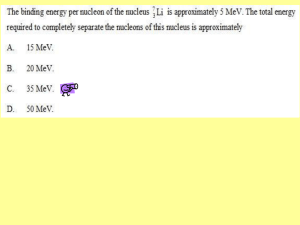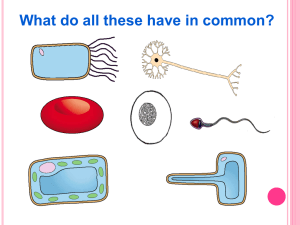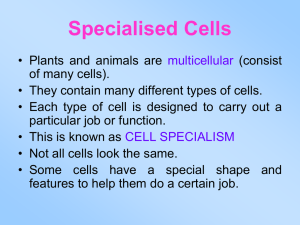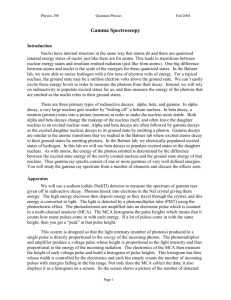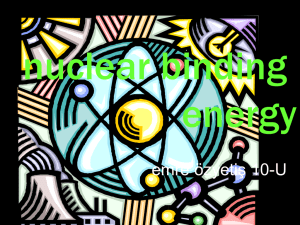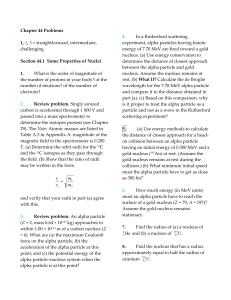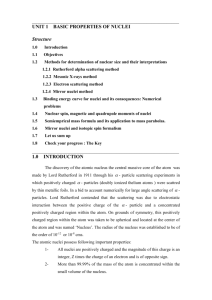NUCLEAR
advertisement
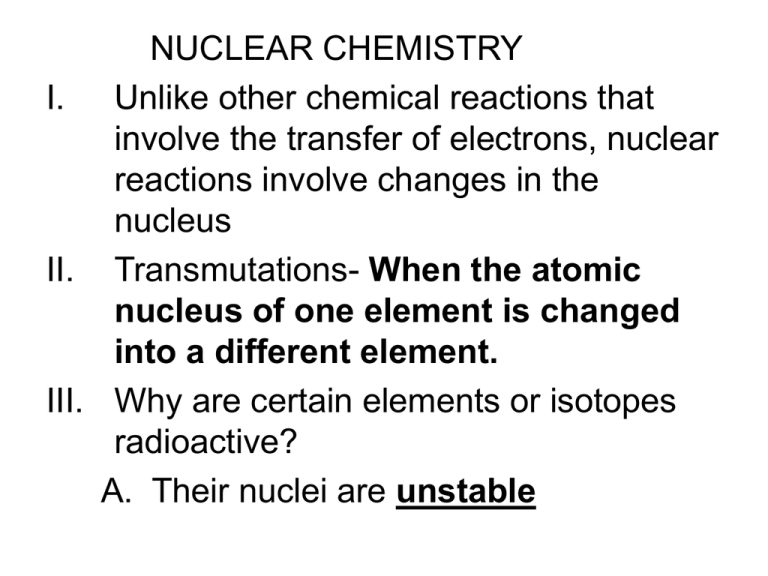
NUCLEAR CHEMISTRY I. Unlike other chemical reactions that involve the transfer of electrons, nuclear reactions involve changes in the nucleus II. Transmutations- When the atomic nucleus of one element is changed into a different element. III. Why are certain elements or isotopes radioactive? A. Their nuclei are unstable B. Nuclei become unstable when the ratio of neutrons to protons becomes greater than 1.5 (approximately) C. All elements with an atomic number greater than 83 are radioactive and all their isotopes D. Elements with atomic numbers less than 83 have some isotopes that are radioactive and some that are stable. IV. Unstable Nuclei Spontaneously decay to Produce Stable nuclei by: Alpha Decay-When an unstable nucleus emits an alpha particle 1. Table O 2. alpha particle is a helium nucleus 3. Symbol: 42He or α 4. Example 226 Ra --- 222 Rn + 4 He 88 86 2 B. Beta Decay- when an unstable nucleus emits a beta particle. 1. Table O 2. Beta particle is an electron 3. Symbol: 4. Example: 23490 Th-- 23491 Pa + 0-1 e C. Positron Emission- When an unstable nucleus emits a positron 1. Table O 2. Positron is a positive electron 3. Symbol: 0+1e orβ+ 4. Example: 37 K 37 Ar + 0 e 19 18 +1 D.Gamma Radiation 1. Table O 2. Similar to high energy x-rays Not particles and do not have mass 3. Symbol: ɤ E. Table N shows types of decay (transmutations) exhibited by various nuclei V. Nuclear Equations A. Balancing 1. Both mass and charge are conserved 2. The top number means mass 3. The bottom number means charge 4. The sum of the upper numbers (mass) on each side and the lower numbers (charge) on each side must be equal. 5. Example + 10n 2411Na + X Top = 28 Top = 24 so x must have a mass of 4 Bottom = 13 Bottom = 11 so X must have charge of +2 Use the periodic table or table O to identify X it is 42He 27 Al 13 VI. Transmutations A. Natural- When an unstable nuclei spontaneously emits an alpha particle, gamma ray, beta particle or positron. 1. All natural transmutations have only one reactant 2. Example: 23994 Pu 23592U + 42He B. Artificial- When a nucleus is bombarded with high energy particles which brings about a change in the nucleus. 1. Two types a. Collision of a charged particle with the nucleus aa. The charged particle is accelerated to a high speed in a device called a cyclotron or synchrotron. These devices use electric and/or magnetic fields to speed up a charged particle so it can enter the nucleus bb. Example 32 P + 0 e 32 Si 15 -1 14 • b. Collisions of neutrons with a nucleus aa. The neutron is captured by the strong force that holds protons and neutrons in the nucleus. bb. Example 238 1 n 239 U U + 92 0 92 c. To tell the difference between artificial and natural transmutations look at the left side of the equation. Natural transmutations have a single nucleus on the left and artificial transmutations have two reactants. VII. SEPARATING EMANATIONS 1. Done by using electric and magnetic fields 2. In an electric field, alpha particles are deflected toward the negative electrode, beta particles are deflected toward the positive electrode and gamma rays are unaffected. VIII. Fission and Fusion A. Fission- The splitting of a heavy nucleus to produce lighter nuclei by capturing a neutron 1. Product of fission are two middle weight nuclei, one or more neutrons, and energy 2. Products are highly radioactive 3. This is the type of nuclear reaction used in power plants 4. Example: 1 n +235 U 142 Ba +91 Kr+31 n + 0 92 56 36 0 energy B. Fussion- Combining of light nuclei to form heavier one 1. This is the process that occurs on the sun 2. The light elements are generally hydrogen or helium 3. Require extremely high temperatures 4. Products are not radioactive 5. Example: 1 H + 1 H 2 H + 0 e IX. HALF-LIFE A. Definition- Time required for one half of the nuclei in a given sample to decay B. The shorter the half-life the less stable the nucleus C. Table N Example: What mass of I-131 remains after 32 days if you start with 100g. To solve set up a table number of ½ lives time amount (g) • 0 0 100g • 1 ½ life 8 days 50g • 2 ½ lives 16 days 25 g • 3 ½ lives 24 days 12.5 g • 4 ½ lives 32 days 6.25 g Examples: Analysis of a charred piece of coal reveals it contains ¼ of the C-14 that is found in living tissue. Assume you started with 1gram # ½ lives Time amount (g) 0 ½ lives 0 1 1 ½ life 5,770y ½ 2 ½ lives 11,540 y ¼ X. Uses of Radioisotopes A. Dating 1. C-14 is used to date once living organisms 2. U-238 decays into Pb-206 and the ratio of U-238/Pb-206 is used to date rocks and other geological formations B. Chemical Tracers – a radioactive substance is used to follow the path of a material within a system 1. P-31 Present in fertilizers and is used to follow plant process 2. C-14 can be used to follow metabolic processes C. Industrial applications 1. Gamma rays can be used to measure the thickness of materials or test the strength of a weld. The more gamma rays a substance absorbs the thicker it is. D. Medical Applications- Certain radioisotopes that are quickly eliminated from the body and have short half-lives are important as tracers in medical diagnosis. 1. I-131 used to diagnose thyroid disorders 2. Cobalt-60 emits large amounts of gamma arrays and can be aimed at tumors to kill cancerous cells 3. Technetium-99 is rapidly absorbed by cancer cells. It is given to patients so tumors can be detected in scans, 4. Co-60 and Cs-137 are sources of gamma rays used to kill anthrax 5. Intense beams of gamma radiation can be used to irradiate foods to kill bacteria. XI. Risks of Radiation 1. Exposure to high doses of radiation can cause radiation sickness, cancer and mutation in cells. 2. The by-products of nuclear power plants, spent fuel rods and equipment, are highly radioactive with long half-lives and must be stored for many years. 3. Safety issues associated with nuclear power plants. Chernobyl in the Ukraine, 3 mile island in US.


